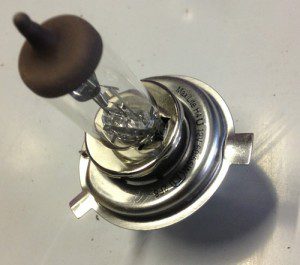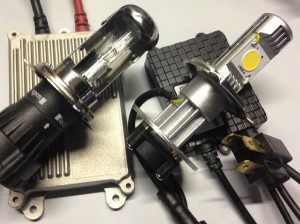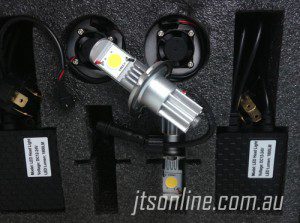
Although the whole automotive industry uses them, only a few people actually know how they evolved from simple acetylene lamps in the 1880s to very complex LED assemblies nowadays. Furthermore, researchers are continuously working on the whole “headlamp” idea, trying to find new breakthroughs that would obviously make their products better than the rivals’.
We won’t talk about the head lamp history today because we already did that, but instead we’ll try to focus on the three major headlamp configurations and see what they’re up to. We’ll thus try to discuss the advantages and disadvantages of each of them, although people generally believe, and it sometimes happens to be true, that the newest is also the best. Some of you will agree with our statements, other won’t, but either way, each of the three types of headlamps has its very own pros and cons. So, let’s take one at a time and see what this is all about.
HALOGEN HEADLAMPS
Halogen headlights are currently the most popular in the automotive world and, in case you’re wondering why does this happen, it’s mostly because of their primary advantage: they have a very long life. Basically a halogen light bulb has a lifetime of about 1,000 hours under normal conditions, while replacement costs are usually very low. However, halogen bulbs are becoming the second option for more and more car companies around the world. The reason? Halogen isn’t exactly synonym to efficiency and, to better understand why, we’ll explain how such a light bulb works.

The biggest problem is that, while generating the radiating light, the bulb also creates a large amount of heat which basically represents wasted energy.
When the halogen light bulb comes to the end of its lifetime, it usually happens so because the tungsten in the filament evaporates and leaves the filament, finally reaching the glass and causing the light to burn.
Another major problem with halogen bulbs is also the way they react to various substances. For example, when replacing a faulty bulb, it is mandatory to avoid touching the glass! The salt in the skin oil can result in damages to the glass of the bulb which won’t resist too much to the high temperature inside.
Still, halogen light bulbs have a number of advantages that could make it the number one option for most carmakers: they create a brighter illumination, mostly thanks to the heat generated by the filament; they come in a number of different sizes, which basically means that such bulbs can be installed on most car models; they are dimmable, thus allowing car makers to build multiple versions, depending on body type and dimensions.
In just a few words, there are the pros and cons of halogen headlamps:
ADVANTAGES:
- longer life
- different dimensions
- very efficient
- bright illumination
DISADVANTAGES:
- energy wasting
- require extra care
Xenon headlights, officially known as high-intensity discharge headlamps, are usually known as a more efficient solution, mostly because of the color temperature and the amount of light they generate. Such a lamp contains xenon gas, hence the slight blue tint of the light (as recorded by the naked eye).
The first xenon headlight appeared on the BMW 7 Series in 1991 and slowly became the number one option for several car companies, which avoided however to offer it as standard equipment.
We won’t go too far in details to explain you what a xenon bulb is made of or how the whole system work, but we’ll focus on our subject and try to discover advantages and disadvantages.

Of course, xenon lamps have slowly became available in a number of sizes and versions, especially to be used on various types of cars.
Efficiency on the other hand might be the number one thought when thinking to choose HID detrimental to other types of lights. Efficiency of the light bulb not only means less used energy but also reduced fuel consumption and less CO2 emissions, as a certain amount of power sent to the headlamps could be used for a wide array of electronic systems.
It is generally believed that xenon lights have a pretty long lifetime, exceeding the one of halogen lamps: estimates are pointing to an operation life of around 2,000 hours in normal conditions.
Of course, there are also some setbacks that could make people believe that xenon isn’t exactly the best solution for their cars.
For instance, the amount of glare generated by the headlamps might be extremely disturbing for the other drivers on the road, especially for incoming traffic, thus raising the number of accidents and fatalities caused by other than speed and technical problems.
Second of all, HID lights are more expensive at almost any given chapter, regardless if we’re discussing about installation costs, replacing or maintenance.
Last but not least, some xenon headlamps could have a harmful impact on our health, as some versions could contain toxic substances, such as metal mercury. Some countries have imposed special regulations that require a number of light bulbs to contain mercury but, of course, this would only lead to higher production and repair costs.
So, to review the pros and cons of xenon lights:
ADVANTAGES:
- longer lifetime than halogen lights
- more efficient than halogen as they use less power
- better visibility to the driver
DISADVANTAGES:
- too much glare and thus, potential problems for the incoming traffic
- very high costs
- possible harmful materials could be used
The automotive industry has evolved a lot, that’s for sure. Along with it, headlamps have reached another level and, after car makers closely analyzed the way halogen or HID lights influence their models, turn to another option: LED’s. At least on paper, LED’s seem to be the solution for mass-produced cars but there are also several setbacks that could change the world’s perspective over this type of technology.

There are a number of issues to be clarified however. For example, although LED’s do not emit heat as they emit light, as it’s the case of the halogen headlights, they create a certain amount of heat at the bottom of the emitter, thus creating a potential risk for adjacent assemblies and connectivity cables. Automakers are generally avoiding using LED’s for headlights especially for this reason but, instead, they’re adopting the technology for turn signals, daytime running lights or brake lamps.
Thanks to their small size, LED’s allow great manipulation, thus allowing producers to create all kinds of shapes and assemblies that would perfectly match their models.
The amount of power generated by light-emitting diodes is generally believed to be in between the ones produced by halogen and xenon lamps but, with the efforts made by car makers, LED’s are likely to improve a lot in the future.
However, if there’s an aspect to be significantly improved, it is surely the production cost. At the present time, LED’s are pretty expensive and are only offered, mostly as options, on premium to luxurious cars. LED’s appeared for the first time in 2004, but the first model that came with full LED headlamps was the Audi R8.
So, here’s what we’ve learned about LED headlights:
ADVANTAGES:
- small size, allow great manipulation for various shapes
- very low energy consumption
DISADVANTAGES:
- high production costs
- low amount of generated power
- high temperature created around adjacent assemblies
ARTICLE CREDIT: http://www.autoevolution.com/news/battle-of-the-headlights-halogen-vs-xenon-vs-led-26530.html
